The following post is a result of initial information received from Enrique Kunz and thereafter further research to, I believe, prove a theory that the bricks below were made in Scotland for the South American Railways.
I have found several bricks marked FCCA, FCCC, FCO, FCSO, FCS, FCC, FCP, FCB, FCBA and BAP.
Some of these bricks have associated, Thistle, Glenboig or GEM (Castlecary) marks. I had, up until 28/11/2015, been unable to identify what the marks above referred to.
Enrique Kunz put forward an interesting theory. He believed these bricks were made in Scotland for use on the Argentine railway network.
FCCA
He believed it is possible that bricks marked FCCA were made for the Central Argentine Railway. FC (railway) C (Central) A(Argentine). It was a British enterprise established in Argentina in 1863 and sold to the government in 1948.
The Central Argentine Railway (CA) (in Spanish: Ferrocarril Central Argentino) was one of the Big Four broad gauge, 5 ft 6 in (1,676 mm), British owned companies that built and operated railway networks in Argentina. The company was established in the 19th century, to serve the provinces of Santa Fe and Córdoba, in the east-central region of the country. Source
Ferrocarril Central Argentino (FCCA) became the Ferrocarril Nacional General Bartolome Mitre.
English Name: Central Argentine Railway.
 .
. 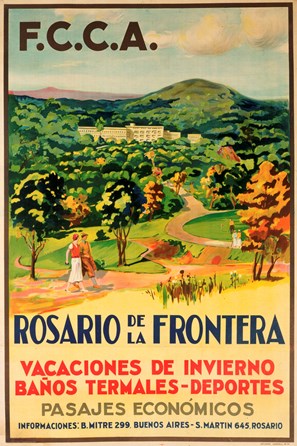
.

Below – A Bonnybridge FCCA brick – Bonnybridge Silica & Fireclay Co Ltd, Bonnybridge.

Below – A Glenboig brick – Glenboig Union Fireclay Works, Glenboig.

Below – A Thistle brick. Stein, Castlecary Fireclay Works, Castlecary, Stirlingshire

Below – A Castlecary brick. Weir, Castlecary Fireclay & Lime Works, Castlecary, Stirlingshire.

Below – A Gartcosh brick. Gartcosh Fireclay Works, Gartcosh, Glasgow.

Below – Further convincing evidence as the following 2 bricks were found by Enrique on the FCCA railway network.

.

Below – And these found by Pablo Marzilio in Argentina.
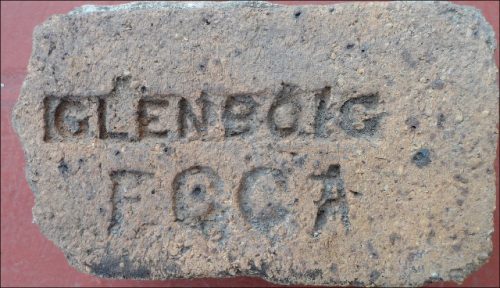
.
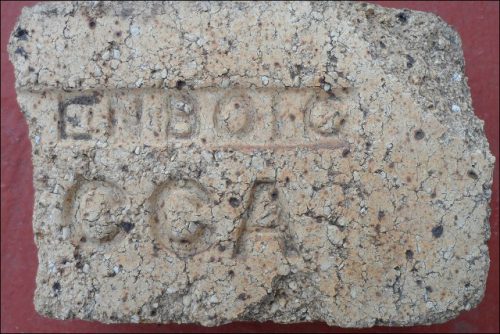
Below – Glenboig FCCA brick found in Rosario, Argentina by Cris Pasquali.

FCO
Enrique wrote further that FCO could refer to the Western Railway in Argentina. British investors bought the railway circa 1884 to Argentine owners. In 1948 the railway was bought by the Argentine government.
Information on FCO
Ferrocarril Oeste (FCO) became the Ferrocarril Nacional General Domingo Faustine Sarmiento – English Name: Buenos Aires Great Western railway
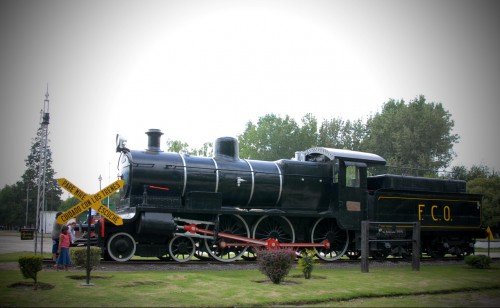
.

Below – An FCO brick found in Barrhead, Paisley. The maker is unidentified but likely Scottish.

Below – An FCO brick found at Drum Farm, Bonnybridge, Scotland among countless ‘Bonnybridge Brand’ bricks. (This was left in situ).

Below – FCO marked bricks found in Mechita, Buenos Aires, Argentina – source

FCS
He also is of the opinion that FCS could refer to the Southern Railway in Argentina. One of the FCS bricks is marked FCS MA1 but he does not know what the MA1 could relate to.
Information on FCS
Ferrocarril del Sud – was one of the Big Four broad gauge, 5 ft 6 in (1,676 mm), British-owned companies that built and operated railway networks in Argentina. The company was founded by Edward Lumb in 1862 and the first general manager was Edward Banfield after whom the Buenos Aires suburban station of Banfield was named when it opened in 1873. After President Juan Perón nationalised the Argentine railway network in 1948 it became part of the state-owned company Ferrocarril General Roca.
Edward Banfield (9 February 1837 – 6 July 1872) was an English railroad engineer who drove the first locomotive (La Porteña) through Buenos Aires, Argentina, in 1857 as part of the Buenos Aires Western Railway. He was the first General Manager of the British-owned Buenos Aires Great Southern Railway between 1865 and 1872, founded in Argentina by Edward Lund in 1862. Banfield died in 1872, and the town of Banfield in Buenos Aires Province, founded in 1873, was named after him. The professional Argentine football club Club Atlético Banfield also carries his name.

Below – FCS MA1 or MAI. Found at the Gartliston Fireclay Works, Glenboig.

Source – The Ferrocarriles del Sur del Perú (FCS), now operated by PeruRail, runs from the coast at Matarani to Cuzco, and to Puno on Lake Titicaca from where steamers and train ferries have been run connecting with Guaqui in Bolivia. (Note – SBH – So the FCS bricks may have been manufactured for use in several countries – Bolivia, Chile or Argentina).
FCSO
Ferrocarril Sud y Oeste – FCSO
The Southern Railway was a company of British capitals which built and operated a railway network in Argentina in the second half of the nineteenth century until the first half of the twentieth century. The company was founded by Edward Lumb in 1862 as Buenos Aires Great Southern Railway (BAGS) and his first general manager was Edward Banfield. WIKI Source.
Below – FCSO Gem. Found at the Castlecary Fireclay & Lime Works, Castlecary. Manufactured by Castlecary Fireclay & Lime Works, Castlecary, Stirlingshire or the Glenboig Union Fireclay Company which took over the Castlecary company and works in 1936 (Via General Refractories, Sheffield) and continued the ‘GEM’ and ‘Castlecary’ brand names.
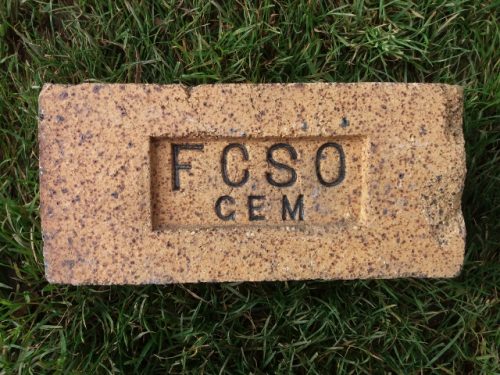
Below – A brick stamped FCSO and found (with several others) on the site of the old Bonnybridge Brickworks, Bonnybridge. So could this have been manufactured by James Dougall of the Bonnydie Brickworks?
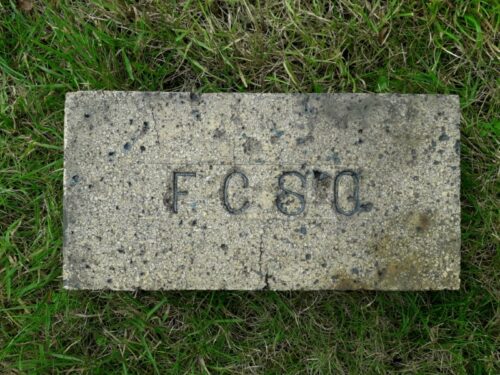
Below – A further FCSO brick but this time with a ‘U’ stamped as an additional mark and this has an unusual ‘lip’ running the length of the brick. It too was found on the site of the old Bonnyside Brickworks.

.

FCCC
In addition to the above, I have a Castlecary FCCC brick and further investigation along the lines of the info above reveals that FCCC also stands for the Central Cordoba Railway, Argentina.
Information on FCCC
Information on FCCC
FCCC = Ferrocarril Central del Chubut. NB In Spanish this should really be abbreviated ‘FCCCh’ as ‘Ch’ counts as a separate single letter in Spanish. However, the railway management always used the English abbreviation FCCC. Source

Below – Castlecary FCCC. Found at the Castlecary Fireclay & Lime Works, Castlecary.

Below – FCCC Forth. Found by Ian Suddaby at Tamfourhill, Falkirk.

… and then again the following is almost too much of a coincidence not to be true – I have bricks marked FCP Forth and BAP Forth.
FCP
FCP = Ferrocarril Patagónico = Patagonian Railway(s), ie the two isolated broad gauge lines and the ex FCCC from 1948 until their takeover by the FC General Roca a few years later.
Ferrocarril al Pacifico (FCP) became the Ferrocarril Nacional General Jose de San Martin
English Name: Buenos Aires and Pacific Railway
Information re FCP
Below – FCP Forth. Found at the Roughcastle Fire Clay Works, Bonnybridge.

Below – A possible FCP brick found in Rosario, Argentina by Cris Pasquali.

FCB
This fire brick was found by Ian Suddaby in the High Bonnybridge area. Several fire brick manufacturers in the area manufactured fire bricks for the South American railway companies. It is almost certain this FCB stamped brick is yet another South American Railway Company although it is uncertain which one exactly.

FCBA
FCBA (Page 6) – Ferrocarril Central de Buenos Aires (FCBA), South American railway network. In 1906, the owners of the FCER and the Central Railroad of Buenos Aires (FCBA), also of standard trail, obtained funds in London for the construction of a line between Buenos Aires and Zárate and, in turn, a ferry from Zárate to the port of Ibicuy in Entre Ríos, so to connect Mesopotamia to Buenos Aires. The modest capital gathered was widely surpassed by the issuance of debt (López, 2007: 97). This was a key moment since it connected the provinces of Entre Ríos, Corrientes and Misiones for the first time with the port of Buenos Aires.
Below – Glenboig FCBA. Found at the Glenboig Union Fireclay Company, Glenboig,

BAP
Buenos Aires and Pacific Railway – BAP
The Buenos Aires and Pacific Railway (BA&P) (in Spanish: Ferrocarril Buenos Aires al Pacífico) was one of the Big Four broad gauge, 5 ft 6 in (1,676 mm), British-owned companies that built and operated railway networks in Argentina.
The original concession was awarded by the Argentine government in 1872 to John E. Clark for the construction of a railway from Buenos Aires to Chile. It was not until 1882, when the BA&P was registered as a joint-stock company in London, that Clark was able to take over the concession
In 1898 the BA&P took over the British-owned company Villa Maria and Rufino Railway and a year later John Wynford Philipps (Many Scottish connections)became chairman of the BA&P, a post he held until 1938. During this period the company developed into a regional amalgamation of companies and dependent lines reaching from Buenos Aires to the Andes and extending from San Juan to Bahía Blanca. In 1907 the Argentine Great Western Railway, which had long been a rival of the BA&P, was taken over. Source
Below – 2 x BAP bricks. Both found at the Roughcastle Fire Clay Works, Bonnybridge.

.

Below – BAP Forth – Forth stamped bricks were a product of the Roughcastle Fireclay Works, Bonnybridge, Scotland. This was found on site.

Below – Dougall BAP – Found at the James Dougall and Sons, Bonnyside Brickworks, Bonnybridge, Stirlingshire, Scotland.

Below – BAP Glenboig – Found at the Glenboig Union Fireclay Company, Glenboig, Lanarkshire.
Alternative brickworks include:
- Glenboig Star Fireclay Works, Glenboig, Lanarkshire.
- Glenboig Fireclay Works, (Old Works) Glenboig, Lanarkshire.

.

FCAB
and yet again this South American Railway connection to a Scottish brickmark – FCAB
The Ferrocarril de Antofagasta a Bolivia (FCAB) started at the Chilean port of Antofagasta. It proceeded up the front range of the Andes to Ollagüe on the Bolivian border, then across the Bolivian pampas to Uyuni and Oruro. At Oruro, the gauge changed to metre gauge for the remainder of the route to La Paz, the capital of Bolivia. A number of branches were added to reach various mining fields. The Collahuasi branch reached 4815 metres (15,795 ft) above sea level, regarded at the time of construction as the highest railway in the world. The total length of 2 ft 6 in (762 mm) gauge lines, including branches and subsidiaries, was 1,537 km (955 mi).
The history of the railway dates back to 1872 with the grant of a concession by the government of Bolivia to Melbourne Clarke & Co, the territory around Antofagasta being part of Bolivia at this date. The railway was organised as the Antofagasta Nitrate & Railway Company. Construction started in 1873, with the first section opening late in that year, motive power provided by mules. Steam locomotives were introduced in 1876, and by 1879 the railway had extended about 150 km into the interior. War broke out in 1879 between Chile on one side, and Peru and Bolivia on the other. One of the causes of the war was an attempt by the Bolivian government to levy back taxes on the railway. The “War of the Pacific” ended in 1883, and Chile gained the region around Antofagasta as well as part of Peru.
Control of the railway passed to the Company Huanchilaca de Bolivia in 1887, who subsequently floated the railway on the London stock exchange in 1888 as the FCAB. The Huanchilaca company retained the right to operate the railway for a further 15 years. The line reached Oruro in Bolivia, the end of the 2 ft 6 in (762 mm) section, in 1892, and branches continued to be added over subsequent years. British business interests resumed control of the entire system in 1903. Traffic reached a point where the port of Antofagasta was unable to cope. A new port was opened to the north at Mejillones in 1906. The entire region is a desert, with almost no rainfall. The company constructed a system of pipes and reservoirs to bring water for the railway from the high Andes, eventually becoming responsible for supplying Antofagasta with water as well.
Bolivian government interests supported the construction of a railway between Oruro and the Bolivian capital, La Paz, and this line was opened in stages between 1908 and 1913 This line was constructed to metre gauge and was leased to the FCAB. The FCAB now had two operating divisions, one using 2 ft 6 in (762 mm) gauge, the other metre gauge. The Chilean 2 ft 6 in (762 mm) gauge track was regauged to one meter in 1926.

Below – GEM FCAB. Found at the Castlecary Fireclay & Lime Works, Castlecary.
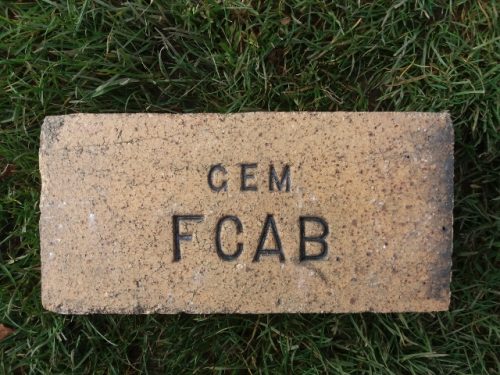
FCC
Below – Bonnybridge FCC. Found at Drum Farm, Bonnybridge near to the Bonnybridge Silica & Fireclay Brickworks, Bonnybridge, Stirlingshire.
(There may be a missing letter FCC?)

“The Córdoba Central Railway (CCR) (in Spanish: Ferrocarril Central Córdoba FCC) was a British-owned railway company, founded in 1887, that operated a 1,960 km (1,220 mi) 1,000 mm (3 ft 3 3⁄8 in) metre gauge railway network in Argentina which extended from Buenos Aires, north-west via Rosario and Córdoba, to Tucumán. Financial problems forced the sale of the company to the Government of Argentina in 1938. When railways were nationalized in 1948 the CC became part of Belgrano Railway.
Enrique has also found Gartcraig, Nettle, Thistle, Gem and Sankey bricks while out researching and visiting the old South American railway system. – click me
An interesting source of information in relation to Scots Railwaymen in Argentina is found on the Scots in Argentina website
Rail in the Argentine
Source
| initials/sigla |
Name in Spanish/Castellano |
Name in English/inglés |
1949 nationalised railway name |
| FCACN, FCNCN (1880-1) |
precursor del F.C. Central Norte Argentino(?) |
Central Northern Railway |
F.C. Gral. Manuel Belgrano |
| FC Andino(1873) |
F.C. Andino |
became part of the Central Argentine Railway |
F.C. Gral. Bartolomé Mitre |
| FCBByNO (1891) |
F.C. Bahía Blanca al Noroeste |
Bahía Blanca and North Western Railway |
F.C. Gral. Julio A. Roca |
| FCBE, FCBAyE, FCE (1865) |
F.C. de la Boca, Barracas y Ensenada,
F.C. Buenos Aires, Ensenada y Costa Sud |
Buenos Aires and Ensenada Port Railway |
F.C. Gral. Julio A. Roca |
| FCByR, FCR, FCBAR (1886) |
F.C. Buenos Aires y Rosario |
Buenos Aires and Rosario Railway |
F.C. Gral. Bartolomé Mitre |
| FCCA, FC Central (1866) |
F.C. Central Argentino |
Central Argentine Railway |
F.C. Gral. Bartolomé Mitre |
| FCCC (1875) |
F.C. Central Córdoba |
Central Cordoba Railway |
F.C. Gral. Manuel Belgrano |
| FCCER (1887) |
F.C. Central Entrerriano |
became part of the Entre Rios Railway |
F.C. Gral. Justo José Urquiza |
| FCCN (1876) |
F.C. Central Norte |
Central Northern Railway |
F.C. Gral. Manuel Belgrano |
| FCCyR (1891) |
F.C. Córdoba y Rosario (vía Río Cuarto) |
Córdoba and Rosario Railway |
F.C. Gral. Manuel Belgrano |
| FCN (1862) |
F.C. Norte de Buenos Aires |
Buenos Aires Northern Railway |
F.C. Gral. Bartolomé Mitre |
| FCNO, FCNOA (1889) |
F.C. Noroeste Argentino |
Argentine North Western Railway |
F.C. Gral. Manuel Belgrano |
| FCNO (c.1887) |
Ferro_Carril Nord Oeste |
North Western of Uruguay Railway |
Administración de Ferrocarriles del Estado |
| FCO (1857) |
F.C. Oeste de Buenos Aires |
Buenos Ayres Western Railway |
F.C. Gral. Domingo F. Sarmiento |
| FCOS (1883) |
F.C. Oeste Santafecino |
Santa Fe Western Railway |
F.C. Gral. Bartolomé Mitre |
| FCP, FCBP (1888) |
F.C. Buenos Aires al Pacífico |
Buenos Aires and Pacific Railway |
F.C. Gral. José de San Martín |
| FCPdeSF (1888) |
F.C. Provincial de Santa Fe |
Province of Santa Fe Railway |
F.C. Gral. Manuel Belgrano |
| FCS, FC del Sud (1865) |
F.C. del Sud |
Buenos Ayres Great Southern Railway |
F.C. Gral. Julio A. Roca |
| FCSFyC (1885) |
F.C. Santa Fe a las Colonias |
became part of the Province of Santa Fe Railway |
F.C. Gral. Manuel Belgrano |
| FCSSFyC (1890) |
F.C. Gran Sur de Santa Fe y Córdoba |
Santa Fe and Córdoba Great Southern Railway |
F.C. Gral. Bartolomé Mitre |
| FCyC (1876) |
F.C. a Campana |
Buenos Ayres and Campana Railway |
F.C. Gral. Bartolomé Mitre |



















































